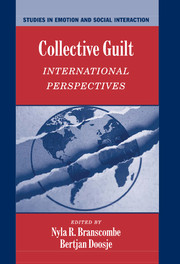Book contents
- Frontmatter
- Contents
- Preface
- List of Contributors
- Collective Guilt
- Section 1 Defining the nature of collective guilt
- Section 2 The Relationship Between Group Identification and Collective Guilt
- 6 Consequences of National Ingroup Identification for Responses to Immoral Historical Events
- 7 Refining the Meaning of the “Collective” in Collective Guilt: Harm, Guilt, and Apology in Australia
- 8 Exonerating Cognitions, Group Identification, and Personal Values as Predictors of Collective Guilt among Jewish-Israelis
- 9 It Depends on Your Point of View: Implications of Perspective-Taking and National Identification for Dutch Collective Guilt
- 10 Collective Guilt, National Identity, and Political Processes in Contemporary Germany
- Section 3 Consequences for Intergroup Relations
- Section 4 Commentary on the Volume
- Index
- References
8 - Exonerating Cognitions, Group Identification, and Personal Values as Predictors of Collective Guilt among Jewish-Israelis
Published online by Cambridge University Press: 05 January 2012
- Frontmatter
- Contents
- Preface
- List of Contributors
- Collective Guilt
- Section 1 Defining the nature of collective guilt
- Section 2 The Relationship Between Group Identification and Collective Guilt
- 6 Consequences of National Ingroup Identification for Responses to Immoral Historical Events
- 7 Refining the Meaning of the “Collective” in Collective Guilt: Harm, Guilt, and Apology in Australia
- 8 Exonerating Cognitions, Group Identification, and Personal Values as Predictors of Collective Guilt among Jewish-Israelis
- 9 It Depends on Your Point of View: Implications of Perspective-Taking and National Identification for Dutch Collective Guilt
- 10 Collective Guilt, National Identity, and Political Processes in Contemporary Germany
- Section 3 Consequences for Intergroup Relations
- Section 4 Commentary on the Volume
- Index
- References
Summary
We explore the reactions of group members when they are confronted with wrongdoing by members of their national group against members of another national group. In our research we assess the viability of both direct and indirect routes to collective guilt, the role that personal values may have on the direct and indirect routes to collective guilt, as well as the potentially complex effects of group identification on the experience of collective guilt. We identify a “paradox of group identification,” in which different aspects of identification with one's national group (i.e., attachment to and glorification of the group) can exacerbate or alleviate collective guilt. Further, we examine the relationships between these aspects of group identification and the moral outrage experienced when harm is done to defenseless people in the context of intergroup conflict by either members of the ingroup, the outgroup, or a third group.
The Israeli-Palestinian conflict has been characterized as one of the most enduring intractable national conflicts (Bar-Tal, 1998; Rouhana & Bar-Tal, 1998). Tragically, as we write, we are in the midst of yet another violent resurgence of the conflict. Our studies examine recent developments in the conflict but also focus on reactions of Israelis to historical events in which they personally played no part.
As is the case for most national groups, both Israelis and Palestinians conceive of themselves as peace-seeking collectives. For example, the Israeli Declaration of Independence, proclaimed on May 14, 1948 amidst the 1948 war, states the following:
We appeal – in the very midst of the onslaught launched against us now for months– to the Arab inhabitants of the State of Israel to preserve peace and participate in the upbuilding of the State on the basis of full and equal citizenship and due representation in all its provisional and permanent institutions.[…]
- Type
- Chapter
- Information
- Collective GuiltInternational Perspectives, pp. 130 - 147Publisher: Cambridge University PressPrint publication year: 2004
References
- 29
- Cited by



